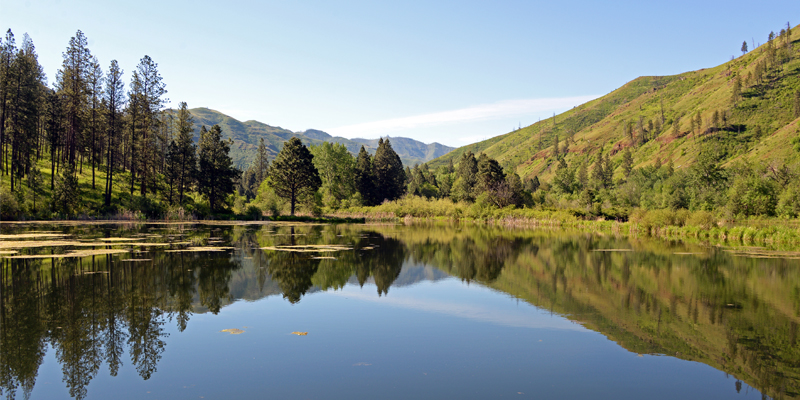
Eastern - Region 1
Customer service staff in the Spokane Regional Office are available for walk-in service 9 a.m. to 4 p.m.
2315 North Discovery Place
Spokane Valley, WA 99216-1566
United States
Fishing tips and news
Warmer weather means hotter fishing
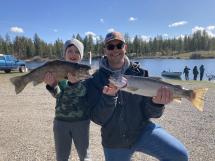
The opening day of fishing season on April 27 was better than the past few years due to warmer water. With the ice
having left area lakes earlier than a lot of years, lake waters had time to warm up somewhat prior to opening day and fish bite better in warmer water.
Lakes across the region were stocked with rainbow trout prior to opening day and many had fry planted last fall that grew over the winter and will make for nice catches this year. You can see all the lakes that were stocked and how many fish were planted in each in the Statewide Hatchery Trout and Kokanee Stocking Plan. It’s also a good idea to check the Sport Fishing Regulations before heading out to fish to make sure you are following all rules and regulations.
There are still lots of fish in regional lakes left over from opening day. In the Spokane area, Badger, Clear and Williams lakes still have plenty of trout left over from the recent opening day crowds.
If you’re interested in size over quantity, you may want to try West Medical Lake. It has some nice-size fish plus some in the 20-inch range.
In northeast Washington, the early spring has made for some decent fishing.
“Cedar, Rocky, Mudgett, Starvation, and Waitts lakes are all providing good fishing so far this season,” said District 1 fish biologist Bill Baker. “Higher elevation waters- such as Big Meadow Lake, the Little Pend Oreille Chain lakes, and more- will heat up as the water continues to warm up in May and June.”
In southeast Washington, most lakes are either open year-round or opened on March 1.
Lakes across the region were stocked with rainbow trout prior to opening day and many had fry planted last fall that grew over the winter and will make for nice catches this year. You can see all the lakes that were stocked and how many fish were planted in each in the Statewide Hatchery Trout and Kokanee Stocking Plan. It’s also a good idea to check the Sport Fishing Regulations before heading out to fish to make sure you are following all rules and regulations. The early spring has also made for some decent fishing in northeast Washington.
Year-round waters
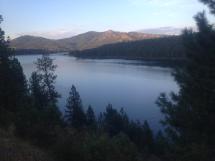
The bigger bodies of water in the area generally fish well year-round and spring is no exception. Lake Spokane (Long Lake), the impoundment of the Spokane River between Nine Mile Dam and Long Lake Dam, has good trout fishing year-round, and fishing for walleye is usually decent as well. For more variety, you can also target yellow perch, black crappie, smallmouth or largemouth bass.
Walleye fishing at Lake Roosevelt will continue to heat up over the next couple of months. The bass (smallmouth and largemouth) fishing opportunity in the Pend Oreille River is also another great option.
Fishing for both rainbow and westslope cutthroat trout at Amber Lake in southwest Spokane County is usually good in the spring. Amber is under selective gear rules so internal combustion motors are prohibited. Bait is strictly prohibited on any lake under selective gear rules. Coffee Pot Lake, in Lincoln County, is another selective gear lake but be aware that because of low water levels, you can’t get back to the lower end of the lake without walking over several hundred yards of dry ground.
If you’re looking to fish for something other than trout, Downs Lake in southwest Spokane County is small so warms up faster than many lakes and fishes well in the spring for yellow perch, black crappie, and largemouth bass.
Bass fishing at Newman Lake, 12 miles east of Spokane, has some quality largemouth, as well as yellow perch, crappie, and some nice sized tiger muskie (Spokane County’s Silver Lake also has tiger muskie) that will become active as the weather warms up.
At the W.T. Wooten Wildlife Area in southeast Washington’s Columbia County, five lakes are open currently- Blue, Spring, Deer, Rainbow, and Watson lakes. Curl Lake opens the Saturday before Memorial Day each year.
Flyfishing
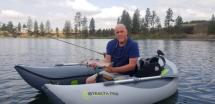
All lakes in northeast Washington are good for flyfishing, but WDFW also manages a handful of fly fishing-only lakes.
Bayley Lake, on the Little Pend Oreille National Wildlife Refuge, is one of the best fly-fishing lakes in eastern Washington, regularly producing big rainbows in the 18 to 20-inch range with some even larger.
McDowell Lake is another fly-fishing only water on the Refuge. Other northeast Washington fly-fishing-only lakes include Long Lake in Ferry County and Browns Lake in Pend Oreille County.
Spokane River fishing
The Spokane River, from Nine Mile Dam upstream to the Idaho state line, does not open until the Saturday before Memorial Day; the same day of the statewide rivers and streams opener.
“Once open, the Spokane River is managed under Selective Gear Rules which prohibits the use of bait,” said Spokane-area District Fish Biologist Randy Osborne. “The river is catch-and-release for all species, except anglers can keep two hatchery rainbow trout with a clipped adipose fin per day.”
Kid’s Fishing Day
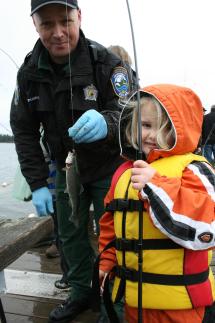
The annual Spokane Kid’s Fishing Event is Saturday, May 11 at Clear Lake. This fun event is a great way to get kids hooked on fishing, especially if they haven’t tried it before. There are lots of volunteers on-hand to help with everything from baiting hooks to taking fish off the line and cleaning them. For a $10 entrance fee, each child gets a fishing rod, t-shirt, and chance to catch up to three fish.
Also new this year, there will be a canned food drive at the event, where any participant donating at least two cans of food will have their name entered into a drawing for a chance to win one of many great prizes provided by area businesses. Prizes include Spokane Indians baseball tickets and apparel, Spokane Chiefs Hockey tickets, passes to multiple trampoline parks and family fun centers, and many more. Donated food will be added to any donated fish caught at the event and will be provided to the North County Food Pantry in Elk to help the families that are still displaced by area wildfires.
Annual Trout Derby
If you catch a tagged trout in many Washington Lakes, you can win a prize! Over one thousand tagged fish were released in lakes across the state this spring and there are over $40,000 in prizes if you catch one. A list of lakes with prize fish is available on the Trout Derby website.
Sullivan Lake proposed bull trout introduction
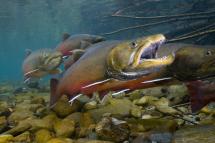
WDFW is partnering with the U.S. Fish and Wildlife Service and the Kalispell Tribe Natural Resources Department on
an initiative to introduce bull trout to Sullivan Lake and Harvey Creek near Metaline Falls in northeast Washington's Pend Oreille County. If it moves forward, this effort will take place over a period of four-to-eight years beginning in 2025. The public comment period to provide input on this proposal has been extended to June 15, 2024. More information on this and how to submit comment is on the WDFW website.
Hunting opportunities and news
Spring turkey
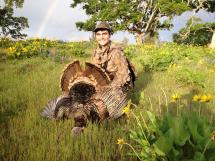
Spring turkey season started in April and continues through the end of May. If you haven’t gotten your birds yet and
are looking for places to hunt, there is plenty of opportunity on public land in Pend Oreille, Stevens and Ferry counties, including the Colville National Forest, the Little Pend Oreille National Wildlife Refuge, and WDFW’s Sherman Creek, LeClerc Creek, and Rustler’s Gulch wildlife areas.
In the southeast part of WDFW’s Region 1, the Asotin Creek, Chief Joseph, and W.T. Wooten wildlife areas also have good hunting opportunity for turkeys.
Special hunt permits
Hunters have through May 15 to apply for special hunting permits for fall deer, elk, mountain goat, moose, bighorn sheep, and turkey seasons. Special permits qualify hunters to hunt at times and places beyond those authorized by a general hunting license.
You do not need to buy a hunting license before submitting a special hunt application for mountain goat, moose, or bighorn sheep, but if drawn, you will need to purchase a license before you get your special hunt permit. Permit winners will be selected through a random drawing by WDFW in June. More information, applications, and licenses are available from license vendors statewide or on WDFW's website. Most special hunt permit applications cost $7.10 for residents, $110.50 for non-residents, and $3.80 for youth under 16 years of age.
Wildlife watching and recreation
Return of the hummingbirds
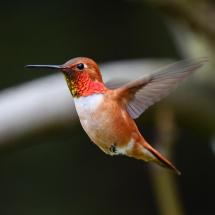
Hummingbirds are back in eastern Washington! Get out your feeders if you haven’t already but remember to clean them regularly this season to help avoid developing bacteria that can make hummingbirds sick.
Avian influenza
Avian influenza may also be returning to the northwest this spring so if you see a dead or sick wild bird, report it to WDFW. Do not touch sick or dead birds or move them. This can spread the virus to areas it doesn’t already exist. Bird flu viruses are not easily transmissible from birds to people, but without proper hygiene, or if in prolonged contact with a sick bird, the risk increases and the virus can spread to humans. While it is extremely unlikely that hunters or people feeding wild birds could contract bird flu, the following precautions are recommended to reduce the risk of contracting any wildlife disease:
- Wear disposable gloves when cleaning harvested birds or cleaning bird feeders.
- Do not harvest or handle wild birds that are obviously sick or found dead.
- Do not eat, drink, or smoke while cleaning game.
- Wash hands with soap and water or use alcohol hand sanitizer immediately after handling.
- Separate raw meat, and anything it touches, from cooked or ready-to-eat foods to avoid contamination.
- Cook game birds thoroughly. Meat should reach an internal temperature of 155 to 165 degrees Fahrenheit to kill disease organisms and parasites. Freezing does not kill the HPAI virus.
Learn more about avian influenza and how to prevent its’ spread in our blog on the topic.
Negative wildlife interactions
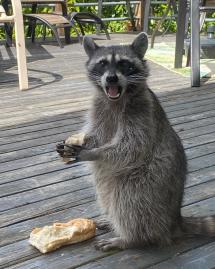
It’s the time of year when small mammals like raccoons, skunks, and marmots can become a nuisance when they
start to nest in places like crawl spaces, under porches, or corners of garages or storage sheds. Learn how to enjoy these wildlife neighbors without problem on WDFW’s website.
You are also more likely to see larger wildlife- like moose with calves, bears, coyotes or cougars- as the weather warms up. Be alert and aware of surroundings and take precautions when hiking, picnicking, or camping. Most wild animals want to avoid people, so make noise to alert animals to your presence. Keep a clean picnic spot to avoid attracting animals with food smells. Learn more about bears, cougars, coyotes and moose on our Living with Wildlife webpages.
Leave wild babies wild
May is a busy month for the birth of baby animals. If you encounter fawns, baby birds, or other young animals, please leave them be, even if they appear to be orphaned or abandoned. Most animals have a parent foraging or hunting nearby. Read our blog to learn about when not to rescue wildlife.
Wildlife Program biweekly reports
To read reports published prior to 2023, visit the Biweekly Wildlife Program activity reports page.
Meet your Regional Director - Mike Kuttel, Jr.
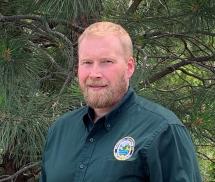
Mike Kuttel Jr. is the Eastern Region (Region 1) Regional Director. Kuttel has been with WDFW since 2015 in two statewide policy positions focused on fish and wildlife conservation and providing recreational opportunities on public and private lands through federal farm bill conservation programs and partnering with the U.S. Forest Service and Washington State Department of Natural Resources on shared stewardship of forests.
Previously, he worked for conservation districts, the Washington State Conservation Commission, and Washington State Department of Ecology. He has a bachelor’s degree in environmental science. Kuttel is a lifelong Washington resident and has lived on both sides of the Cascades. He grew up in southwest Washington fishing and hunting. In his free time, Mike enjoys hunting, fishing, hiking, camping, and foraging for mushrooms and berries with family.